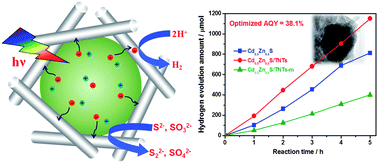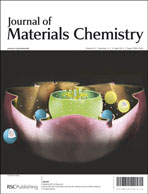Highly efficient visible-light-driven photocatalytic hydrogen production from water using Cd0.5Zn0.5S/TNTs (titanate nanotubes) nanocomposites without noble metals†
Abstract
Semiconductor based nanocomposites are quite promising in the areas of photocatalysis and photovoltaics due to their efficient charge separation. Herein, we demonstrated a simple and green one-step method to prepare novel Cd0.5Zn0.5S/TNTs (titanate nanotubes) nanocomposites with low-priced metallic elements. Transmission electron microscopy (TEM) images revealed that an enwrapped architecture was achieved for Cd0.5Zn0.5S/TNTs nanocomposites. Cd0.5Zn0.5S nanoparticles of ca. 90 nm were tightly surrounded by the network of titanate nanotubes, which led to the high dispersity of Cd0.5Zn0.5S nanoparticles and the intimate multipoint contacts between Cd0.5Zn0.5S and TNTs. Highly efficient charge separation was finally achieved in the hybrid Cd0.5Zn0.5S/TNTs through the enwrapped structure. Under visible light irradiation Cd0.5Zn0.5S/TNTs displayed improved activities compared to the single Cd0.5Zn0.5S for hydrogen evolution. The effect of sacrificial reagents on the photocatalytic activity of Cd0.5Zn0.5S/TNTs was discussed. The highest apparent quantum yield of 38.1% at 420 nm was achieved. This value is among the highest efficiencies for the noble-metal free photocatalysts ever reported. Meanwhile, Cd0.5Zn0.5S/TNTs showed good stability for hydrogen production, and the content of toxic cadmium was as low as 4.0 wt% of the nanocomposites. These factors are of great significance for their application in the field of solar energy conversion.


 Please wait while we load your content...
Please wait while we load your content...